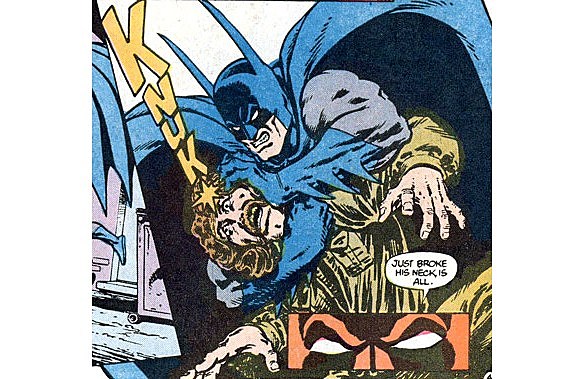
This Issue, Batman Kills: The Dark Knight’s Most Murderous Moments
In last week's "Batman and Robin" #10, Oberon Sexton advanced the theory that the Domino Killer Batman and Robin have been hunting is actually Bruce Wayne, which is somewhat complicated by the fact that Wayne is currently lost in time.
 It's not the first time Batman's billionaire alter-ego has been accused of murder. Heck, the 2002 storyline where Lex Luthor decided to frame him for killing an ex-girlfriend by hiring an assassin who just happened to know that Wayne was also Batman and thus created a drum-tight frame was actually called "Bruce Wayne: Murderer." But of course, it turns out that Batman was innocent, because as everyone knows, the Batman doesn't kill.
It's not the first time Batman's billionaire alter-ego has been accused of murder. Heck, the 2002 storyline where Lex Luthor decided to frame him for killing an ex-girlfriend by hiring an assassin who just happened to know that Wayne was also Batman and thus created a drum-tight frame was actually called "Bruce Wayne: Murderer." But of course, it turns out that Batman was innocent, because as everyone knows, the Batman doesn't kill.
Or does he? Bats might claim to have a code against killing, but over the past 70 years, there sure have been a lot of people who died in the course of the Caped Crusader's war on crime. That's why today, ComicsAlliance builds its case around the times Batman has crossed the line, compiled by resident Batmanologist Chris Sims!
CASEFILE #1: Batman vs. The Golden Age

The earliest version of Batman was less inspired by the wave of super-heroic peers that were rising up in the wake of Superman (who debuted the previous year), and more by hardcore pulp characters like the Shadow. Like the Shadow, the Batman of 1939 was frequently seen carrying a gun -- as seen above on the splash page for a story that, ironically enough, has no actual gunplay within -- and wasn't above using it to put a permanent end to criminals.
In short, during his first year of adventures, Batman straight-up murdered a lot of dudes.
Snapping necks with a kick, throwing crooks out of windows, capping vampires with his .45, the guy is brutal, and it's a trend that started in his very first appearance in "Detective Comics" #27, when he not only punches a crook into a vat of acid...

...but then offers up a pithy, supremely unconcerned remark about it too:

Within a few months, though, Batman's casual disregard for life is replaced by him feeling bad about strangling a henchman with his bat-rope, and then with the institution of the code against killing. There's a common misconception among readers that this was part of the clean-up imposed by the Comics Code, but as Michael Fleisher points out in "The Original Encyclopedia of Comic Book Heroes v.1," a resource without which no Batmanologist should be...

...the time that Batman kills lasts less than two years, and ends a good 13 years before the Code was introduced. Instead, it's part of the natural evolution of the character and the creators -- notably Bill Finger and Jerry Robinson, who realized early on that killing off villains precluded recurring arch-nemeses -- figuring out what worked and what didn't. Thus, the code against killing, which drew the line between pulp vigilante and the newly minted super-hero.
And it's a good thing, too, because punching guys into vats of acid wasn't exactly working out too well for Batman.
CASEFILE #2: THE ATTEMPTED MURDER OF DARKSEID

While Batman's stance against guns has been a long-established part of the character--a necessity of reducing the violence that's been worked into a fundamental part of the story by the murder of his parents at the hands of a pistol-packing hoodlum--there have been a couple of notable exceptions. There's "Batman: Year Two," a polarizing story that straddles the line between hilariously awesome and hilariously awful, which sees Batman claiming that he has no choice but to use the actual gun that killed his parents to fight crime. It is admittedly ludicrous, especially since it tells us a young Bruce Wayne stole the gun from the crime scene and then kept it in a little drawer under a gigantic portrait of the Waynes for years, and it's probably the #1 reason why "Year Two" was retconned out of Batman's "official" history almost as soon as it came out.
More recently, though, he made an exception during "Final Crisis," using a space gun to fire a time bullet at Darkseid, because that sentence is totally awesome the actual, literal God of Evil requires certain allowances.

Unfortunately, despite Batman's best efforts, it wasn't a fatal wound -- at least, not immediately. The Radion poisoning would've gotten him eventually, but it weakened Darkseid enough that Superman was able to cancel out his evil vibrations by singing a song while Wonder Woman stopped him from possessing everyone on Earth by tying him up.
It makes a little more sense when you actually read it.
CASEFILE #3: Batman vs. "Batman"

Every now and then, someone in Gotham City will put on a Batman costume and set about murdering somebody, but unless you're operating on a very loose definition of "Batman," it doesn't really count as the Dark Knight murdering someone. The gentleman doing the neck-snapping above, for instance, might be fighting crime and wearing a Batman costume, but he's not Bruce Wayne, Dick Grayson, or even Terry McGinnis: It's actually ex-policeman Tommy Carma, who sports an absolutely incredible head of hair underneath that cowl.

Carma idolized Batman to the point where he even named his daughter Robin, but when she and his wife were killed by criminals, he -- in a move that I'm almost convinced was writer Max Alan Collins taking a pot-shot at obsessive fans -- moved in with his mom and used his vast collection of Batman memorabilia to wage a one man war on crime that quickly turned murderous.
Batman took him down, but in a second story, Carma killed two orderlies (hallucinating that they were Two-Face and the Joker), and then, in a coincidence that I thought was a stretch even when I was seven, escaped from Arkham Asylum stumbled onto the Batcave, which was right next door. Batman takes him down again, but it's a little disingenuous of him to lecture a guy on not killing anyone, especially given what else was going on in the '80s.
CASEFILE #4: Batman vs. The 80s

In what I can only assume was a round of mass hysteria that afflicted the entire comics industry, the late '80s saw Batman just flat-out killing guys like it was the summer of '39 all over again. Not only was there Tim Burton's wildly popular "Batman" movie, where Batman blew up a factory with people in it, fired machine guns mounted on the batmobile, and threw henchmen and super-villains alike to their deaths from a bell tower, there were also the comics themselves.
ComicsAlliance favorite "Ten Nights of the Beast," for instance, ends with writer Jim Starlin having Batman totally just locking the KGBeast up in a sewer and leaving him to starve to death. It's not undeserved -- in four issues, the Beast racks up a body count of well over a hundred Gothamites -- but it creates a pretty big headache for Marv Wolfman a few years later in a story where he "reveals" that it was all just Batman's idea of Time Out.
In the original story, though...

...it's pretty clear that Batman meant this to be the Capital-E End of the KGBeast.
The most egregious example, though, comes from writer Mike W. Barr (who also wrote "Year Two") and artist Trevor Von Eden, in 1982's "Batman Annual" #8. Lest you think I'm just ragging on Barr here, I will point out that I absolutely love the majority of his Batman comics, which include "Fear For Sale," the greatest Scarecrow story of all time. But this one, "The Messiah of the Crimson Sun"... brother, it's a doozy.
Something about it just doesn't feel like a Batman story to me. The plot centers around a new villain called, fittingly enough, the Messiah of the Crimson Sun, who has a satellite that turns the sun's rays into dehydrating death beams and who Batman has to go out into space to stop. It just seems like it comes from the tradition of James Bond more than Batman, but as that's perfectly in keeping with the O'Neil/Adams world-traveling adventurer stories, that's more of a semantic debate that doesn't really matter here.
What does matter is that when Batman goes out to space to fight the Messiah of the Crimson Sun, who turns out to be Ra's al-Ghul, he totally murders him. They have a kung fu fight in space (which is pretty awesome), and then when Ra's tries to hightail it in an escape pod, Batman uses his bat-spacecraft remote control (?!) to drag him back into the death rays...

...and then drops what is quite possibly the most dismissive jerk line of his entire crimefighting career:

"But Batman... You've KILLED him!"
"Have I, Robin?"
Yes, Batman! Yes you have!
Ra's eventually came back -- it's what he does, after all, and to my knowledge this story was never mentioned again -- but that doesn't change the fact that Batman dragged him into a death ray, then popped his spacecraft open in hard vacuum and then watched his ashes float by. For all intents and purposes, Robin's right: He did kill Ra's al-Ghul.
The Golden Age stuff can be written off as a character settling in, Darkseid's an extenuating circumstance, and Tommy Carma just plain isn't Batman. Even the KGBeast was retconned back to life a few years later. But whacking Ra's al-Ghul with a Space Laser? That one needed "Crisis on Infinite Earths" to take it out.
More From ComicsAlliance








![Five Stars: Starting At The End With Jeff Smith [Interview]](http://townsquare.media/site/622/files/2017/03/FiveStars-Smith.jpg?w=980&q=75)
